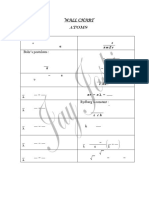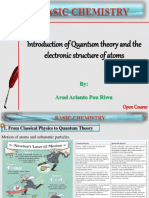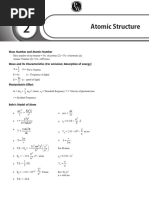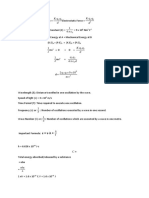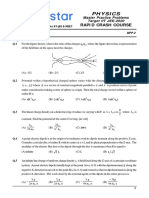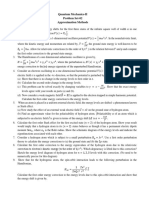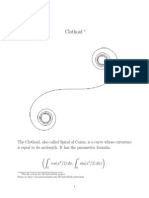Intensive Revision Program of Physical Chemistry: By: Brijesh Jindal Sir
Uploaded by
Hudsun HornetIntensive Revision Program of Physical Chemistry: By: Brijesh Jindal Sir
Uploaded by
Hudsun HornetIntensive Revision Program
of
Physical Chemistry
By : Brijesh Jindal Sir
KEY CONCEPT
STRUCTURE OF ATOM
1. Rutherford's Model
(a) Electrons, protons & neutrons are the most important fundamental particles of atoms of all elements
(Except hydrogen)
(b) Z
XA , Mass number (A) = Atomic number (Z) + number of neutrons (n)
(c) Rn = R1 (A)1/3 , R1 = 1.33 ×10–13 cm A = mass number
1 Z . 2e
(d) m v 2 K ; r = distance of closest approach , v = initial velocity of a -particle
2 r
2. Light
(a) Photon is considered massless bundle of energy.
(b) E = mc2
(c) Ephoton = h = hc/ = hc
hc 1240 eV . nm
(d) E=
no. of molecules reacting
(e) Quantum efficiency or Quantum Yield =
no. of quanta absorbed
Atomic.pmd 1 12/25/2019, 1:22 PM
3. Bohr’s Model
Kq1q 2 1
(a) Electrostatic force = where K = 4 = 9 × 109 N-m2 / C2
r2 0
Kq1q 2
(b) Potential energy due to electrostatic force =
r
KQ
(c) Potential due to a charge particle (Q) at a distance r =
r
h
(d) Bohr quantization rule mvr = n· = n .
2
(e) According to newtons second law in a uniform circular motion resultant of all the forces towards
mv 2
centre must be equal to .
r
Kq1q 2 mv 2
(f)
r2 r
E1 2 2 2 me 4 K 2 2 2 2 me 4 K 2 Z 2
(g) En = Z =– Z ; E1 =
n
2 n 2h 2 h2
2 2
h n
(h) rn = 2 2
4 e m K Z
2
2e K Z
(i) vn =
h n
(j) Revolutions per sec = v/2r
(k) Time for one revolution = 2r/v
(l) Ionisation energy = E n – Eelectron = – Eelectron
4. Spectral lines
1 1 1 2
RH
2
(a) Rydberg’s Equation 2
— Z ; RH 109700 cm–1
n1 n 2
(b) For First line of a series n2 = n1 + 1
(c) Limiting spectral line (series limit) means n2 =
(d) H line means n2 = n1+1 ; also known as line of longest , shortest , least E
Atomic.pmd 2 12/25/2019, 1:22 PM
(e) Similarly H line means n2 = n1+ 2
n (n 1)
(f) Number of spectral line observed in the spectrum =
2
when e– de-excites to ground state , n = number of higher orbit
(g)
n=5
n=4
Bracket
series
n=3
Paschen
series
n=2
Balmer
series
n=1
H H H
Lyman
series
5. Photoelectric effect
(a) Kinetic energy = = h – w = h – h0
where w = work function
0 = Threshhold frequency
1 2
(b) Accelerating potential = eV = KE = mv
2
(c) 1/2 = a(z–b) b = screening constant
6. De-broglie, Heisenberg & Schrodinger equations
(a) Number of waves = n = principal quantum number
(b) = h/mv = h/p
150
(c) wavelength of electron () Å
Vin volts
(d) x.p h/4
h
(e) Orbital angular momentum = l (l 1)
2
h
(f) Spin angular momentum = S = S(S 1)
2
(g) Magnetic momentum () = n ( n 2) B.M. ; n = number of unpaired electron
Atomic.pmd 3 12/25/2019, 1:22 PM
(h) Radial Nodes = (n – l – 1)
(i) Angular nodes =l
(j) Total nodes = (n–1)
7. Terms associated with elements
(a) Isotopes
(b) Isobars
(c) Isotones (A – Z)
(d) Isoelectronic
(e) Isosters
(f) Isodiaphers (A – 2Z)
(g) paramagnetic
(h) Diamagnetic
8. Eleectromegnetic Spectrum
increases
Cosmic -rays X-rays Vaccum UV Visible Near Far Micro Radio
Rays UV IR IR Waves Waves
= –14 –11 –9 –7 –6 –5 –3 –1 0
10 10
–13
10 10 10 10 10 10 10 10
–10 –8 –4 –2
10 10 10 10
–12
10
Atomic.pmd 4 12/25/2019, 1:22 PM
Fill in the blanks :
Q.1 Radiation of = 155 nm was irradiated on Li (work function = 5 eV) plate. The stopping potential
(in eV) is __________.
Q.2 Increasing order of magnetic moment among the following species is ________.
Na+, Fe+3, Co2+, Cr+2
Q.3 If in the hydrogen atom P.E. at is chosen to be 13.6 eV then the ratio of T.E. to K.E. for 1st orbit of
H-atom is ________.
Q.4 The light radiations with discrete quantities of energy are called ______.
Single correct :
Q.5 The ratio of the energy of a photon of 2000 Å wavelength radiation to that of 4000 Å radiation is
(A) 1 / 4 (B) 4 (C) 1 / 2 (D) 2
Q.6 The energy of electron is maximum at
(A) Nucleus (B) Ground state
(C) First excited state (D) Infinite distance from the nucleus
Q.7 Which electronic level would allow the hydrogen atom to absorb a photon but not to emit a photon
(A) 3s (B) 2p (C) 2s (D) 1s
Q.8 The third line in Balmer series corresponds to an electronic transition between which Bohr’s orbits in
hydrogen
(A) 5 3 (B) 5 2 (C) 4 3 (D) 4 2
Q.9 The orbital angular momentum of an electron in 2s orbital is:
1
(A) . (B) Zero (C) (D) 2.
2 2 2 2
Q.10 Which quantum number is not related with Schrodinger equation
(A) Principal (B) Azimuthal (C) Magnetic (D) Spin
Q.11 The shortest wavelength of He atom in Balmer series is x, then longest wavelength in the Paschene
series of Li+2 is
36 x 16 x 9x 5x
(A) (B) (C) (D)
5 7 5 9
Q.12 An electron in a hydrogen atom in its ground state absorbs energy equal to the ionisation energy of
Li+2. The wavelength of the emitted electron is:
(A) 3.32 ×10–10 m (B) 1.17 Å (C) 2.32 × 10–9 nm (D) 3.33 pm
Atomic.pmd 5 12/25/2019, 1:22 PM
Q.13 An electron, a proton and an alpha particle have kinetic energies of 16E, 4E and E respectively. What
is the qualitative order of their de Broglie wavelengths?
(A) e > p = (B) p = > e (C) p > e > (D) < e » p
Q.14 Given H for the process Li(g) Li+3(g) + 3e– is 19800 kJ/mole & IE1 for Li is 520 then IE2 &
IE3 of Li+ are respectively (approx, value)
(A) 7505 , 11775 (B) 520 , 19280 (C) 11775 , 19280 (D) Data insufficient
Q.15 The ratio of difference in wavelengths of 1st and 2nd lines of Lyman series in H–like atom to difference
in wavelength for 2nd and 3rd lines of same series is:
(A) 2.5 : 1 (B) 3.5 : 1 (C) 4.5 : 1 (D) 5.5 : 1
Q.16 If radius of second stationary orbit (in Bohr's atom) is R. Then radius of third orbit will be
(A) R/3 (B) 9R (C) R/9 (D) 2.25R
Q.17 The ratio of wave length of photon corresponding to the -line of Lyman series in H-atom and -line
of Balmer series in He+ is
(A) 1 : 1 (B) 1 : 2 (C) 1 : 4 (D) 3 : 16
Q.18 Three energy levels P, Q, R of a certain atom are such that EP < EQ < ER. If 1, 2 and 3 are the wave
length of radiation corresponding to transition R Q ; Q P and R P respectively. The correct
relationship between 1, 2 and 3 is
1 1 1 2 1 1
(A) 1 + 2 = 3 (B) (C) 3 = 1 2 (D)
3 1 2 3 1 2
Q.19
The value of (n2 + n1) and n 22 n12 for He+ ion in atomic spectrum are 4 and 8 respectively. The
wavelength of emitted photon when electron jump from n2 to n1 is
32 9 9 32
(A) R (B) R (C) 32 R (D) 9 R
9 H 32 H H H
Q.20 Number of possible spectral lines which may be emitted in bracket series in H atom, if electrons
present in 9th excited level returns to ground level, are
(A) 21 (B) 6 (C) 45 (D) 5
Q.21 The first use of quantum theory to explain the structure of atom was made by :
(A) Heisenburg (B) Bohr (C) Planck (D) Einstein
Q.22 The wavelength associated with a golf weighing 200g and moving at a speed of 5m/h is of the order
(A) 10–10m (B) 10–20m (C) 10–30m (D) 10–40m
Atomic.pmd 6 12/25/2019, 1:22 PM
Q.23 The longest wavelength of He+ in Paschen series is "m", then shortest wavelength of Be+3 in Paschen
series is (in terms of m):
5 64 53 7
(A) m (B) m (C) m (D) m
36 7 8 64
Q.24 What is uncertainity in location of a photon of wavelength 5000Å if wavelength is known to an accuracy
of 1 pm?
(A) 7.96 × 10–14 m (B) 0.02 m (C) 3.9 ×10–8 m (D) none
Q.25 Consider the following nuclear reactions involving X & Y.
X Y + 42 He
Y 8O18 + 1H1
If both neutrons as well as protons in both the sides are conserved in nuclear reaction then moles
of neutrons in 4.6 gm of X
(A) 2.4 NA (B) 2.4 (C) 4.6 (D) 0.2 NA
Q.26 Electromagnetic radiations having = 310 Å are subjected to a metal sheet having work
function = 12.8 eV. What will be the velocity of photoelectrons with maximum Kinetic Energy..
(A) 0, no emission will occur (B) 2.18 × 106 m/s
(C) 2.18 2 × 106 m/s (D) 8.72 × 106 m/s
Q.27 Assuming Heisenberg Uncertainity Principle to be true what could be the minimum uncertainty in
de-broglie wavelength of a moving electron accelerated by Potential Difference of 6 V whose uncertainty
7
in position is n.m.
22
(A) 6.25 Å (B) 6 Å (C) 0.625 Å (D) 0.3125 Å
Atomic.pmd 7 12/25/2019, 1:22 PM
SUBJECTIVE
Q.28 The wavelength of a certain line in the Paschen series in 1093.6 nm. What is the value of nhigh for this
line. [RH = 1.0973 × 107 m1]
Q.29 Calculate the total energy emitted when electrons of 1.0 g atom of hydrogen undergo transition giving
the spectral line of lowest energy in the visible region of its atomic spectrum.
Q.30 Calculate the wavelength in angstrom of photon that is emitted when an e in Bohr orbit n=2 returns to
the orbit n=1. The ionization potential of the ground state of hydrogen atom is 2.17×1011 erg/atom.
Q.31 A doubly ionised lithium atom is hydrogen like with atomic number z = 3. Find the wavelength of the
radiation required to excite the electron in Li2+ from the first to the third Bohr orbit.
Q.32 A stationary He+ ion emitted a photon corresponding to a first line of the Lyman series. The photon
liberated a photoelectron from a stationary H atom in ground state. What is the velocity of photoelectron.
Q.33 A metal was irriadated by light of frequency 3.2 × 1015 S1. The photoelectron produced had its KE,
2 times the KE of the photoelectron which was produced when the same metal was irriadated with a
light of frequency 2.0 ×1015 S1. What is work function.
Q.34 A potential difference of 20 KV is applied across an X-ray tube. Find the minimum wavelength of X-
ray generated.
Q.35 Find the number of photons of radiation of frequency 5 × 1013 s–1 that must be absorbed in order to
melt one gm ice when the latent heat of fusion of ice is 330 J/g.
Q.36 Suppose 1017 J of light energy is needed by the interior of the human eye to see an object. How many
photons of green light ( = 550 nm) are needed to generate this minimum amount of energy.
Q.37 Through what potential difference must an electron pass to have a wavelength of 500 Å.
Q.38 To what effective potential a proton beam be subjected to give its protons a wavelength of 1 ×1010
m.
Atomic.pmd 8 12/25/2019, 1:22 PM
Q.39 The quantum yield for decomposition of HI is 0.2. In an experiment 0.01 moles of HI are decomposed.
Find the number of photons absorbed.
Q.40 A base ball of mass 200 g is moving with velocity 30 × 102 cm/s. If we can locate the base ball with an
error equal in magnitude to the of the light used (5000 Å), how will the uncertainty in momentum be
compared with the total momentum of base ball.
Q.41 An electron has a speed of 40 m/s, accurate up to 99.99%. What is the uncertainity in locating its
position.
Q.42 A cylindrical source of light which emits radiation radially (from curved surface) only, placed at the
centre of a hollow, metallic cylindrical surface, as shown in diagram.
The power of source is 90 watt and it emits light of wavelength 4000 Å only. The emitted photons
strike the metallic cylindrical surface which results in ejection of photoelectrons. All ejected
photoelectrons reaches to anode (light source). The magnitude of photocurrent is
[Given : h = 6.4 × 10–34 J/sec.]
Q.43 Mr. Santa has to decode a number "ABCDEF" where each alphabet is represented by a single digit.
Suppose an orbital whose radial wave function is represented as
(r) = k1 ·e r / k 2(r2 – 5k3r + 6k 32 )
From the following information given about each alphabet then write down the answers in the form of
"ABC", for above orbital.
Info A = Value of n where "n" is principal quantum number
Info B = No. of angular nodes
Info C = Azimuthal quantum number of subshell to orbital belongs
(Assuming k3= 1)
Atomic.pmd 9 12/25/2019, 1:22 PM
ANSWER KEY
OBJECTIVE
Q.1 3 eV Q.2 Na+, Co2+, Cr2+, Fe3+ Q.3 zero Q.4 photons
Q.5 D Q.6 D Q.7 D Q.8 B Q.9 B Q.10 D Q.11 B
Q.12 B Q.13 A Q.14 A Q.15 B Q.16 D Q.17 A Q.18 B
Q.19 C Q.20 B Q.21 B Q.22 C Q.23 D Q.24 B Q.25 B
Q.26 C Q.27 C
SUBJECTIVE
Q.28 6 Q.29 1.827 × 105 J/mol Q.30 1220 Å
Q.31 113.74 Å Q.32 3.09 × 108 cm/sec Q.33 319.2 KJ/mol
Q.34 0.62 Å Q.35 10 22 Q.36 28 photons
Q.37 6.03×10–4 volt Q.38 0.0826 volts Q.39 3 × 1022
Q.40 1.75 × 10–29 Q.41 0.0144 m Q.42 10 amp
Q.43 300
Atomic.pmd 10 12/25/2019, 1:22 PM
You might also like
- ATOMIC STRUCTURE_1_99df6bc8-b41e-4dbf-8d85-72ec941ccc87No ratings yetATOMIC STRUCTURE_1_99df6bc8-b41e-4dbf-8d85-72ec941ccc876 pages
- Atoms _ Short Notes __ Yakeen NEET 2.0 2025 (Legend)No ratings yetAtoms _ Short Notes __ Yakeen NEET 2.0 2025 (Legend)1 page
- Atoms: Recall What Did You Study in Previous ClassNo ratings yetAtoms: Recall What Did You Study in Previous Class1 page
- Atoms _ Short Notes __ Vijeta Series Class-12thNo ratings yetAtoms _ Short Notes __ Vijeta Series Class-12th1 page
- 65e6e66c729e4a001888356d - ## - ATOMS Short NotesNo ratings yet65e6e66c729e4a001888356d - ## - ATOMS Short Notes1 page
- JEE Main Question Paper Session 2 April 6 Physics Reliable KotaNo ratings yetJEE Main Question Paper Session 2 April 6 Physics Reliable Kota13 pages
- Atomic Structure - Short Notes - Arjuna NEET 2025No ratings yetAtomic Structure - Short Notes - Arjuna NEET 20252 pages
- Atomic Structure : Short Notes || Arjuna NEET 2024No ratings yetAtomic Structure : Short Notes || Arjuna NEET 20242 pages
- Atomic Structure Short Notes by amit mahajan sirNo ratings yetAtomic Structure Short Notes by amit mahajan sir2 pages
- Atomic Structure : Short Notes || Arjuna NEET 2025No ratings yetAtomic Structure : Short Notes || Arjuna NEET 20252 pages
- Complete Physical Chemistry (Revision 01)No ratings yetComplete Physical Chemistry (Revision 01)2 pages
- XII H - 15 Structure of Atoms and Nuclei - 64ca32cdee566No ratings yetXII H - 15 Structure of Atoms and Nuclei - 64ca32cdee56622 pages
- 665816f7947f47001832821e - ## - 02 - Atomic Structure - TheoryNo ratings yet665816f7947f47001832821e - ## - 02 - Atomic Structure - Theory2 pages
- Material_9ff004ab-8bf0-4d1a-8927-892f5feae59eNo ratings yetMaterial_9ff004ab-8bf0-4d1a-8927-892f5feae59e7 pages
- Modern Physics-02-Objective Solved Problems1No ratings yetModern Physics-02-Objective Solved Problems15 pages
- Feynman Lectures Simplified 2C: Electromagnetism: in Relativity & in Dense MatterFrom EverandFeynman Lectures Simplified 2C: Electromagnetism: in Relativity & in Dense MatterNo ratings yet
- Problems in Quantum Mechanics: Third EditionFrom EverandProblems in Quantum Mechanics: Third EditionD. ter Haar3/5 (2)
- Electron Beam-Specimen Interactions and Simulation Methods in MicroscopyFrom EverandElectron Beam-Specimen Interactions and Simulation Methods in MicroscopyNo ratings yet
- Intensive Revision Program of Physical Chemistry: By: Brijesh Jindal SirNo ratings yetIntensive Revision Program of Physical Chemistry: By: Brijesh Jindal Sir12 pages
- Intensive Revision Program of Physical Chemistry: By: Brijesh Jindal SirNo ratings yetIntensive Revision Program of Physical Chemistry: By: Brijesh Jindal Sir9 pages
- Intensive Revision Program of Physical Chemistry: By: Brijesh Jindal SirNo ratings yetIntensive Revision Program of Physical Chemistry: By: Brijesh Jindal Sir11 pages
- Solid State Theory Physics 545: The Lattice Specific HeatNo ratings yetSolid State Theory Physics 545: The Lattice Specific Heat56 pages
- TUTORIAL - CHAPTER 2 (Geometric Aspects in Cartography) : SUG262 (Principles of Cartography)No ratings yetTUTORIAL - CHAPTER 2 (Geometric Aspects in Cartography) : SUG262 (Principles of Cartography)4 pages
- Class 12 Revised Syllabus For 2023 Board Examination-1No ratings yetClass 12 Revised Syllabus For 2023 Board Examination-114 pages
- Quantum Mechanics-II Problem Set-02 Approximation MethodsNo ratings yetQuantum Mechanics-II Problem Set-02 Approximation Methods2 pages
- Linjin Zheng - Magnetically Confined Fusion Plasma Physics, Volume 3 - Kinetic Theory-IOP Publishing (2022)No ratings yetLinjin Zheng - Magnetically Confined Fusion Plasma Physics, Volume 3 - Kinetic Theory-IOP Publishing (2022)260 pages
- Paul R - Halmos Measure Theory Graduate Texts Inbookfi-OrgNo ratings yetPaul R - Halmos Measure Theory Graduate Texts Inbookfi-Org8 pages
- Heilbronner: Hückel Molecular Orbitals of Möbius - Type ConformationsNo ratings yetHeilbronner: Hückel Molecular Orbitals of Möbius - Type Conformations6 pages
- Universal Wavefunction - Wikipedia, The Free EncyclopediaNo ratings yetUniversal Wavefunction - Wikipedia, The Free Encyclopedia2 pages
- Atom Interferometry and Its ApplicationsNo ratings yetAtom Interferometry and Its Applications49 pages
- LEC. (1) - Kinematics of Rigid Bodies-Definitions-Translation-Rotational Motion-ExamplesNo ratings yetLEC. (1) - Kinematics of Rigid Bodies-Definitions-Translation-Rotational Motion-Examples7 pages
- Vorticity Equation: 13.021 - Marine HydrodynamicsNo ratings yetVorticity Equation: 13.021 - Marine Hydrodynamics12 pages
- AP EAMCET 2023 Weightage For Physics - Check Chapter-Wise Weightage Here - CollegeDekhoNo ratings yetAP EAMCET 2023 Weightage For Physics - Check Chapter-Wise Weightage Here - CollegeDekho1 page
- ATOMIC STRUCTURE_1_99df6bc8-b41e-4dbf-8d85-72ec941ccc87ATOMIC STRUCTURE_1_99df6bc8-b41e-4dbf-8d85-72ec941ccc87
- Atoms _ Short Notes __ Yakeen NEET 2.0 2025 (Legend)Atoms _ Short Notes __ Yakeen NEET 2.0 2025 (Legend)
- Atoms: Recall What Did You Study in Previous ClassAtoms: Recall What Did You Study in Previous Class
- JEE Main Question Paper Session 2 April 6 Physics Reliable KotaJEE Main Question Paper Session 2 April 6 Physics Reliable Kota
- Atomic Structure : Short Notes || Arjuna NEET 2024Atomic Structure : Short Notes || Arjuna NEET 2024
- Atomic Structure : Short Notes || Arjuna NEET 2025Atomic Structure : Short Notes || Arjuna NEET 2025
- XII H - 15 Structure of Atoms and Nuclei - 64ca32cdee566XII H - 15 Structure of Atoms and Nuclei - 64ca32cdee566
- 665816f7947f47001832821e - ## - 02 - Atomic Structure - Theory665816f7947f47001832821e - ## - 02 - Atomic Structure - Theory
- Feynman Lectures Simplified 2C: Electromagnetism: in Relativity & in Dense MatterFrom EverandFeynman Lectures Simplified 2C: Electromagnetism: in Relativity & in Dense Matter
- Problems in Quantum Mechanics: Third EditionFrom EverandProblems in Quantum Mechanics: Third Edition
- Electron Beam-Specimen Interactions and Simulation Methods in MicroscopyFrom EverandElectron Beam-Specimen Interactions and Simulation Methods in Microscopy
- Intensive Revision Program of Physical Chemistry: By: Brijesh Jindal SirIntensive Revision Program of Physical Chemistry: By: Brijesh Jindal Sir
- Intensive Revision Program of Physical Chemistry: By: Brijesh Jindal SirIntensive Revision Program of Physical Chemistry: By: Brijesh Jindal Sir
- Intensive Revision Program of Physical Chemistry: By: Brijesh Jindal SirIntensive Revision Program of Physical Chemistry: By: Brijesh Jindal Sir
- Solid State Theory Physics 545: The Lattice Specific HeatSolid State Theory Physics 545: The Lattice Specific Heat
- TUTORIAL - CHAPTER 2 (Geometric Aspects in Cartography) : SUG262 (Principles of Cartography)TUTORIAL - CHAPTER 2 (Geometric Aspects in Cartography) : SUG262 (Principles of Cartography)
- Class 12 Revised Syllabus For 2023 Board Examination-1Class 12 Revised Syllabus For 2023 Board Examination-1
- Quantum Mechanics-II Problem Set-02 Approximation MethodsQuantum Mechanics-II Problem Set-02 Approximation Methods
- Linjin Zheng - Magnetically Confined Fusion Plasma Physics, Volume 3 - Kinetic Theory-IOP Publishing (2022)Linjin Zheng - Magnetically Confined Fusion Plasma Physics, Volume 3 - Kinetic Theory-IOP Publishing (2022)
- Paul R - Halmos Measure Theory Graduate Texts Inbookfi-OrgPaul R - Halmos Measure Theory Graduate Texts Inbookfi-Org
- Heilbronner: Hückel Molecular Orbitals of Möbius - Type ConformationsHeilbronner: Hückel Molecular Orbitals of Möbius - Type Conformations
- Universal Wavefunction - Wikipedia, The Free EncyclopediaUniversal Wavefunction - Wikipedia, The Free Encyclopedia
- LEC. (1) - Kinematics of Rigid Bodies-Definitions-Translation-Rotational Motion-ExamplesLEC. (1) - Kinematics of Rigid Bodies-Definitions-Translation-Rotational Motion-Examples
- AP EAMCET 2023 Weightage For Physics - Check Chapter-Wise Weightage Here - CollegeDekhoAP EAMCET 2023 Weightage For Physics - Check Chapter-Wise Weightage Here - CollegeDekho















